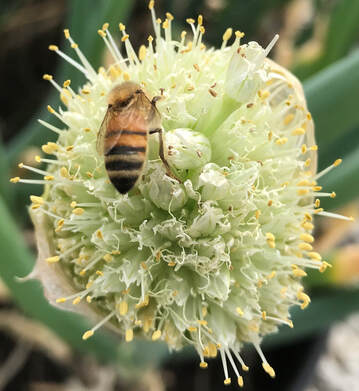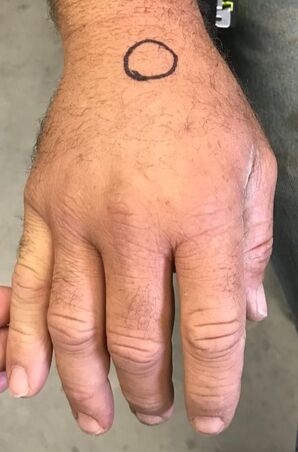|
For most people a bee sting is just a bother not really life threatening but for a honeybee it does mean death. Honeybees are the only type of bee that dies after they sting you. Wasps and other species don't lose their stingers so they may sting you more than once. When a bee stings you, it leaves behind a venomous toxin that can cause pain and other symptoms. Some people are allergic to this toxin. Mild allergic reactions may cause redness and increased swelling at the sting site. Yesterday Mike was walking around at the beehives and he walked into the path of a busy bee and it stung his hand. We had places to go so we just went ahead and left. As we were driving down the road he sees the stinger still in his hand. Not thinking he just reaches down and grabs it. He notices that his hand is swelling pretty badly. He took a Benadryl. a couple hours later his hand is still swelling so we took another Benadryl. and still a couple more hours it is still not going down any so we took another Benadryl. None the less to say he slept real good last night. When he woke up this morning his hand is still really swollen so I started doing research. I found a great article on healthline.com for home remedies for bee stings so this is where I got my information for the blog. Please go check out their website it is very informational. Mike at this point had already told me where he went wrong. The problem was where he just reached down and grabbed the stinger. It released any and all venom that it had in it still. You are supposed to take your fingernail or a credit card of some type and rub it against it to remove the stinger. This will help curb the amount of toxins released into your skin. Then it is best to wash the site with soap and water and apply ice. The ice is the most effective way to reduce venom absorption. It will also help reduce the swelling. In the picture below this is Mike's hand this morning. We just put a circle around the place that the stinger was for our own purpose. It was hard to tell since it was so swollen. If you are not allergic to bees you can treat most bee stings at home. Most home treatments aren't supported by scientific research but they have been passed down by generations. I was raised on home remedies. 1. Honey - may help with wound healing, pain, and itching. To treat bee stings with honey, apply a small amount to the affected area. Cover with a loose bandage and leave on for up to an hour. 2. Baking soda - A paste made of baking soda and water can help neutralize bee venom to reduce pain, itching, and swelling. Apply a thick layer of baking soda paste to the affected area. Cover the paste with a bandage. Leave on for at least 15 minutes and re-apply as needed. 3. Apple cider vinegar- Vinegar may also help neutralize bee venom. Soak the sting site in a basin of apple cider vinegar for at least 15 minutes. You can also soak a bandage or cloth in the vinegar and then apply it to the sting site. 4. Toothpaste - It’s unclear why toothpaste can help bee stings. Some people claim that alkaline toothpaste neutralizes acidic honeybee venom. If true, however, toothpaste won’t work on alkaline wasp venom. Either way, toothpaste is an inexpensive and easy home remedy to try. Simply dab a bit on the affected area. 5. Meat tenderizer - An enzyme in meat tenderizer called papain is also believed to help break down the protein that causes pain and itching. To treat a bee sting this way, make a solution of one-part meat tenderizer and four-parts water. Apply to the sting site for up to 30 minutes. 6. Wet aspirin tablet - A popular home remedy for reducing the pain and swelling of a bee sting is to apply a wet aspirin or aspirin paste to the sting site. Results of one 2003 studyTrusted Source showed that applying aspirin topically to bee stings or wasp stings actually increased redness and didn’t decrease the duration of swelling or pain compared to using ice alone. 7. Herbs and oils - These herbs have wound-healing properties and may help relieve symptoms of a bee sting:
Just remember to take your fingernail or a card or something and rub over it to pull the stinger out do not reach down and just grab it. If you have any of the following issues after a honeybee sting or any other sting you may be having a severe allergic reaction and you would need to seek emergency help. Some people have life threatening allergic reactions to stings so don't wait to long to seek out assistance.
I hope this blog finds everyone doing great on this Friday. I just wanted to take a minute to share this learning moment to just take a second to think and don't always be in such a hurry. It probably would have saved him a little misery if he would have slowed down a minute to just think. I know from now on we both will realize instantly what needs to be done in case of a honeybee sting. Remember Louderbranch Farms is the flavor you can't forget! Happy Memorial Day Weekend Everyone! Information from: https://www.healthline.com/health/outdoor-health/home-remedies-for-bee-stings#home-remedies
1 Comment
Milinda cobb
5/22/2020 01:01:26 pm
I loved the information given it was so informative and we need it these fays
Reply
Leave a Reply. |
AuthorThe voice behind the blog will be Mike & Rhonda Loudermilk. Life at Louderbranch Farms is very far from simple. It is very complicated at times. We would love to live a slower paced life but that is just not possible for what we are trying to accomplish. We both work full time jobs for others plus have our own business. We spend most of our time working. That is what we do! We love gardening, caring for our animals and making handmade bath products such as Rhonda Lynne's Ole Fashioned Soap. Archives
March 2022
Categories |





 RSS Feed
RSS Feed